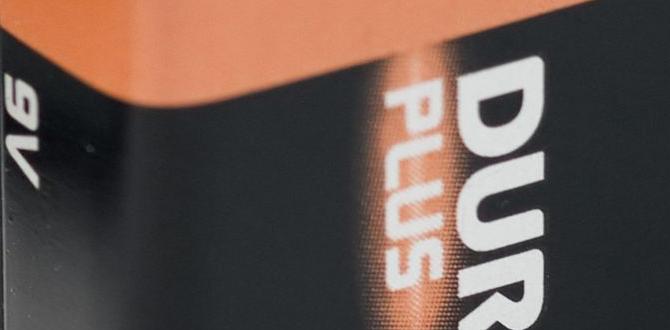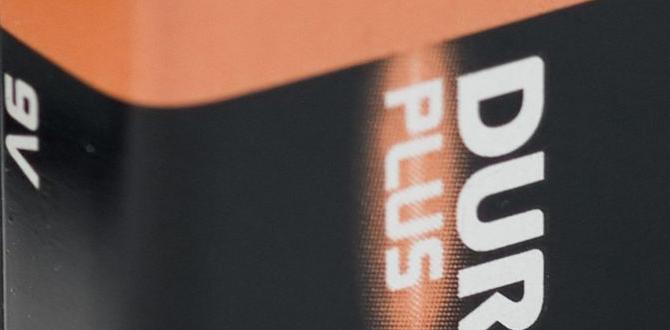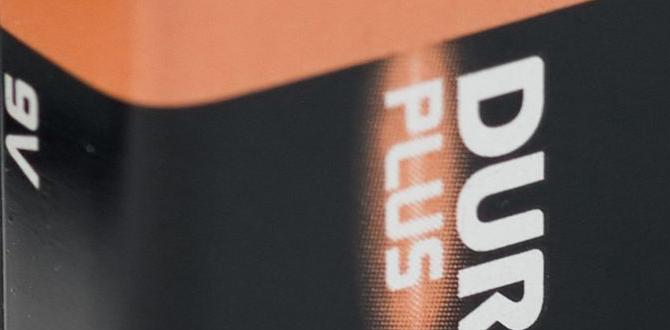Quick Summary:
While most modern electric cars don’t use traditional water for their batteries, older “lead-acid” car batteries do require specific types of distilled water. This guide will help you understand what water to use, how to check your battery’s water level, and the safe way to top it up if needed, ensuring your car battery stays healthy and functional.
Many car owners wonder about water and their car batteries. It’s a simple question that can lead to a lot of confusion, especially with so many different types of cars on the road today. Does every car battery need water? If so, what kind? And how much?
If you have a car with a traditional style battery, often called a lead-acid battery, then yes, it likely needs checking for water levels. These batteries work using a liquid electrolyte, and sometimes, that liquid can get low.
Don’t worry if this sounds a bit technical; we’re going to break it down. This guide will show you exactly what you need to know about water for your car battery. We’ll cover which batteries need water, the right kind of water to use, and how to check and add it safely. Let’s get your battery in top shape!
Understanding Your Car Battery and Water
When we talk about “water for car batteries,” we’re usually referring to older types of car batteries. These are the classic lead-acid batteries that have been around for a long time. They are common in many gasoline and some older hybrid vehicles.
Inside these batteries are cells. Each cell contains lead plates submerged in a mixture of water and sulfuric acid. This mixture is called the electrolyte. As the battery charges and discharges, a process called electrolysis happens, which can cause some of the water to evaporate over time. This is why some batteries need a “top-up.”
However, it’s crucial to know that most brand-new cars, especially electric vehicles (EVs) and many newer gasoline cars, use sealed battery systems. These are designed to be maintenance-free and do not have caps for adding water. Trying to open them or add water would likely damage the battery and is absolutely not recommended.
Types of Car Batteries
Let’s quickly look at the main types of car batteries you might encounter:
- Lead-Acid Batteries: These are the ones that might need water. They can be “flooded” (requiring maintenance) or “sealed” (maintenance-free, but still lead-acid). Flooded types typically have removable caps.
- Absorbent Glass Mat (AGM) Batteries: These are a type of sealed lead-acid battery. They do not require water.
- Lithium-Ion Batteries: These are used in all-electric vehicles (EVs) and many hybrid vehicles. They are completely sealed and do not use water in the way traditional batteries do. They have complex cooling systems.
So, the first step is to identify your car battery type. If your battery has removable caps on top, it’s likely a flooded lead-acid type that might need attention. If it’s a sealed unit with no caps, do not attempt to open it for adding water.
Why Checking Battery Water is Important (For Applicable Batteries)
For flooded lead-acid batteries, regular checks are important to keep them healthy and performing well. Here’s why:
- Electrolyte Level: The lead plates inside the battery need to be fully submerged in the electrolyte (water and acid mixture). If the water evaporates, the electrolyte level drops.
- Plate Exposure: When the plates are exposed to air, they can corrode and become damaged. This is called sulfation, and it’s bad for the battery. Damaged plates mean a weaker battery that might not hold a charge well or start your car.
- Battery Life: Keeping the water level correct helps your battery last longer. A well-maintained battery is a reliable battery.
- Performance: A low electrolyte level can affect the battery’s ability to deliver power, making it harder to start your car, especially in cold weather.
Think of it like checking the oil in your car. It’s a routine task that prevents bigger, more expensive problems down the line.
What Kind of Water Should You Use for a Car Battery?
This is a crucial question, and the answer is simple and specific: always use distilled water.
Why distilled water? Let’s break it down. Tap water and even filtered water contain minerals and impurities. These minerals can:
- React with the battery’s acid and plates.
- Cause buildup inside the battery.
- Damage the battery’s internal components.
- Reduce the battery’s efficiency and lifespan.
Distilled water is pure water that has had almost all impurities removed through a process called distillation. It’s chemically neutral and won’t introduce anything harmful to your battery’s delicate chemistry. This is why it’s the only recommended type of water.
Where to Buy Distilled Water
Finding distilled water is easy! You can usually find it at:
- Most supermarkets (in the cleaning or bottled water aisle).
- Drugstores or pharmacies.
- Automotive parts stores.
- Big box retailers.
Grab a gallon jug; it’s inexpensive and will last you a long time for this purpose.
How to Check Your Car Battery’s Water Level
Checking your car battery’s water level is a straightforward process, but it requires a few safety precautions and the right tools.
Safety First!
Car batteries contain sulfuric acid, which is corrosive. Always follow these safety tips:
- Wear Safety Glasses: Protect your eyes from any potential splashes.
- Wear Gloves: Protect your skin from acid.
- Work in a Well-Ventilated Area: Batteries can release flammable hydrogen gas, especially when charging. Avoid sparks or open flames.
- Keep Apparel Clear: Don’t wear loose clothing that could catch fire or get chemicals on it.
- Know Where to Find Baking Soda: Have a box of baking soda and water handy. If acid spills on you or surfaces, a baking soda and water mix can neutralize it.
Tools You’ll Need
- Safety glasses
- Rubber or chemical-resistant gloves
- A clean, dry cloth or paper towels
- A flashlight (optional, but helpful)
- Distilled water
- A small funnel (optional, for easier pouring)
Step-by-Step Checking Procedure
Follow these steps carefully:
Step 1: Locate Your Battery
Pop your car hood open. Your battery is usually located on one side of the engine compartment. Consult your car’s owner’s manual if you can’t find it.
Step 2: Clean the Top of the Battery
Before opening any caps, use your dry cloth to wipe away any dust, dirt, or debris from the top of the battery. You don’t want any of that junk falling into the cells.
Step 3: Identify the Cell Caps
Look for a row of small, removable caps on the top of the battery. There are usually six caps, corresponding to the six cells in a standard 12-volt battery. Some batteries might have a single long strip that lifts up or twists off instead of individual caps.
Step 4: Remove the Caps
Gently pry off the caps. You might need a flat-head screwdriver to carefully lift them, or they may simply pull off. Be careful not to force them or damage the battery casing.
Step 5: Inspect the Electrolyte Level
Look inside each cell opening. You should see the liquid electrolyte covering the tops of the internal plates. There is usually a small plastic indicator ring or mark inside each cell that shows the correct level. The electrolyte should be right up to or just covering this indicator.
Here’s what to look for:
- Correct Level: The liquid is visible and covers the internal plates/indicator mark.
- Low Level: You can see the tops of the lead plates, and they look dry or chalky. The liquid level is clearly below the indicator mark.
- Too High: In rare cases, a battery might have been overfilled. The liquid would be significantly above the indicator mark.
Use your flashlight to get a clear view if needed.
Step 6: Replace the Caps (If Not Adding Water)
If the water level is fine in all cells, simply press the caps securely back into place. Make sure they are seated tightly.
How to Add Distilled Water to Your Car Battery
If you find that one or more cells are low on electrolyte, it’s time to add distilled water. Remember, only use distilled water.
When to Add Water
Only add water if the electrolyte level is low enough to expose the tops of the lead plates. Never add water if the level appears correct. Overfilling can cause acid to spill out during charging or driving. A common guideline from sources like AAA suggests checking your battery water levels every few months or at least twice a year.
Step-by-Step Filling Procedure
Once you’ve identified a low cell and have your distilled water ready:
Step 1: Ensure Safety Precautions are in Place
Re-read the “Safety First!” section above. Wear your safety glasses and gloves.
Step 2: Remove the Cell Caps
Gently pry off the caps for the cells that need filling. Work on one cell at a time if you’re unsure.
Step 3: Prepare to Pour
You can pour directly from the distilled water jug, or use a small, clean funnel attached to the jug’s spout for better control. Make sure no other liquids have ever been in the funnel.
Step 4: Add Distilled Water Slowly
Carefully add a small amount of distilled water to the low cell. You want to bring the level up to just covering the lead plates or reaching the indicator mark. Avoid overfilling!
Tip: It’s better to add too little and do a second check than to add too much at once. You can always add more, but you can’t easily take it out.
Step 5: Check the Level Again
After adding a little water, check the level again. Does it look right? Does it reach the indicator mark or just cover the plates? Continue adding small amounts until the level is correct in that cell.
Step 6: Repeat for Other Low Cells
If other cells are also low, repeat steps 4 and 5 for each of them.
Step 7: Securely Replace All Caps
Once all cells have the correct water level, press each cap firmly back into its place. Ensure they are sealed properly to prevent evaporation and contamination.
Step 8: Clean Up
Wipe away any drops of water or potential acid with your cloth. Dispose of your gloves and any cleaning cloths properly.
Important Considerations When Adding Water
- Never Use Tap Water: We can’t stress this enough. Only distilled water.
- Never Use Battery Acid: You do not need to add acid, only water to replace what has evaporated. The acid level remains concentrated as the water evaporates.
- Do It When Battery is Cool: It’s generally best to check and top up when the battery is at a normal temperature. Avoid doing it right after the car has been driven hard or while the battery is actively charging in the car, as the electrolyte can expand and overflow.
- What If My Battery is Sealed? If you have a sealed lead-acid battery (like many AGM types) or an EV battery, do NOT attempt to open it or add water. These systems are not designed for user maintenance of this nature.
Signs Your Car Battery Might Need More Than Just Water
While adding distilled water can help revive a struggling flooded lead-acid battery, it’s not a miracle cure for all battery problems. Sometimes, a battery is simply old or damaged and needs replacing.
Here are signs that indicate your battery might be failing and just adding water won’t be enough:
Battery Performance Issues:
- Slow Engine Crank: The engine turns over sluggishly when you try to start it.
- Clicking Noise When Starting: You hear a rapid clicking sound but the engine doesn’t start.
- Dim Headlights or Interior Lights: Lights seem weaker than usual, especially when the engine isn’t running.
- Corrosion on Terminals: While some corrosion is normal and can be cleaned, excessive white or bluish powdery buildup can indicate leakage and damage.
- Swollen or Bloated Battery Case: This is a serious warning sign of internal damage, often caused by overcharging or extreme heat. Do not attempt to open or fill such a battery.
- Battery Warning Light: Your dashboard may display a battery-shaped warning light.
- Age: Most car batteries last 3-5 years. If yours is older, it might be nearing the end of its life regardless of maintenance.
If you notice any of these symptoms, it’s a good idea to have your battery tested at an auto parts store or by a mechanic. Many stores offer free battery testing. If the test shows the battery is weak or dead, replacement will be necessary. For more information on battery testing, you can check resources like those from AutoZone, which often provide complimentary checks.
Battery Maintenance Table: Key Differences
To help clarify which batteries need what, here’s a quick comparison:
| Battery Type | Requires Water Additive? | Type of Water to Use (If Applicable) | Maintenance Needs | Typical Use |
|---|---|---|---|---|
| Flooded Lead-Acid (Maintenance-Type) | Yes, if electrolyte level is low. | Distilled Water ONLY. | Regular checking of electrolyte levels, cleaning terminals. | Older gasoline vehicles, some conventional hybrids. |
| Sealed Lead-Acid (AGM, Gel) | NO. These are sealed and do not have accessible cells. | N/A. | Keep terminals clean, ensure good connection. | Many modern gasoline vehicles, start-stop systems. |
| Lithium-Ion | NO. These batteries are completely sealed and managed by complex electronics and cooling systems. | N/A. | Primarily requires ensuring the vehicle’s charging and thermal management systems are functioning correctly (handled by manufacturer/mechanic). | All-electric vehicles (EVs), most modern hybrid vehicles. |
As you can see, the need for water is quite specific to older, traditional battery designs.
Frequently Asked Questions (FAQ)
Here are some common questions beginner car owners have about water and their batteries:
Q1: Can I use regular tap water in my car battery?
A: Absolutely not. Tap water contains minerals and impurities that can seriously damage your car battery’s internal components and shorten its lifespan. Always use 100% distilled water for any battery that requires it.
Q2: How often should I check my car battery’s water level?
A: For older, flooded lead-acid batteries, it’s a good practice to check the water level at least twice a year, perhaps when you get your oil changed or before and after the winter season. If you live in a very hot climate where evaporation might be faster, you might want to check more often.
Q3: My battery only has one big cap on top, not individual ones. What do I do?
A: Some older batteries have a single strip that acts as a cover for all the cells. If it lifts or twists off, you can remove it to inspect the electrolyte levels, typically visible through semi-transparent cells or small openings. If your battery is completely sealed with no visible way to access cells, it’s a maintenance-free type and does not require water.
Q4: What happens if I overfill my car battery with distilled water?
A: If you add too much water, especially while the battery is warm or charging, the electrolyte can expand and spill out of the caps. This can damage the battery casing, surrounding engine components, and cause corrosive acid leaks. If you accidentally overfill, carefully try to soak up the excess liquid with an absorbent cloth and neutralize any spills with a baking soda and water solution.




